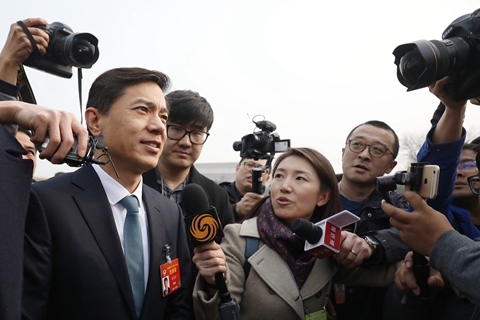结论
对于技术和增长,总是不乏乐观主义者和悲观主义者。乐观主义者往往是技术专家和风险资本家,大都聚集在技术中心。悲观主义者往往是经济学家、社会学家、统计学家和政府官员,多数聚集在主要的州和国家首都。这两个群体之间的互动比各自内部的互动要少得多,他们似乎常常忽视彼此。在本文中我们指出,从某种重要的意义上讲,他们确实是各说各话,缺少沟通。
与乐观主义者交谈时,我们深信最近人工智能和机器学习方面的突破真实而有意义。我们甚至认为,它们是经济上重要的潜在通用技术的新核心。而与悲观主义者交谈时,我们又相信近期生产率增长确已放缓,从中获得的收益分布不均,导致许多人收入停滞不前,健康和福祉指标持续下降,大家有充分理由感到担忧。未来充满不确定性,很多曾经称霸就业和市场价值排行榜的产业巨头都陷入了困境。
这两种叙事并不矛盾。实际上无论从哪方面看,它们都是转型期经济的一致症状。我们的分析表明,虽然最近一段时间经济陷入困顿,但这决定不了什么。尽管做预测总是危险的,而且我们对自己预测未来的能力并非十分有信心,然而我们对证据的解读确实提供了一些乐观的理由。人工智能技术的突破性进展尚未对经济产生大的影响,但是随着扩散,它们的效应将越来越大。更重要的是,它们能够促进互补性创新从而加倍发挥其影响力。人工智能投资和互补性变革都是昂贵和难以测算的,实施起来也需要时间,这至少会在最初阶段降低测算的生产率。企业家、管理者和终端用户将为机器找到强大的新应用程序,这些机器现在就可以学习如何识别对象、理解人类语言、说话、做出准确的预测、解决问题,以及如何以越来越灵活机动的方式与世界互动。
机器学习的核心技术的进一步发展可能带来实质性的利益。然而我们的观点是,被低估的研究领域涉及人工智能新技术的互补品,不仅在人力资本和技能方面,还包括新的流程和商业模式方面。上一轮计算机技术催生的无形资产大约10倍于计算机硬件本身的直接投资。我们认为,与人工智能相关的无形资产看起来有类似甚至更大的规模。鉴于人工智能可能引发协调和生产可能性方面的巨大变化,我们以往组织工作和教育的方式在未来极可能无法保持最佳状态。
相应地,我们需要更新手中的经济测算工具箱。随着人工智能及其互补技术更快地增加我们的(无形)资本存量,传统的指标如GDP和生产率等,可能更难以测算和解释。成功的企业不需要大量投资于工厂甚至计算机硬件,但它们的确拥有难以复制的无形资产。与开发和实施人工智能的企业相关的巨大市场价值表明,投资者相信这些企业具有真正的价值。如果企业资产的所有权公开交易并且市场是有效率的,金融市场就会恰当地评估企业经风险调整后的现金流现值。这可以用来评估企业拥有的有形资产和无形资产的价值。更重要的是,生活水平受到的影响甚至可能超过投资者希望获得的收益。当然更有可能的是,很多人不会分享这些好处。经济学家有能力为研究议程做出贡献,记录和解读人工智能带来的无形变化及其更广泛的经济影响。
人工智能带来的利益还无法自动实现。这需要努力和企业家精神,发展必要的互补技术,培养个人、组织和社会层面的适应性,以推动相关的结构调整。理论预测,赢家将是那些调整成本最低并尽可能多地将合理的互补技术付诸现实的企业。这一定程度上需要运气,但如果有正确的路线图,这些企业和我们所有人就可以未雨绸缪。
(颜超凡 译)
参考文献
Abramovitz,Moses(1956).“Resource and Output Trends in the U.S.since 1870.”American Economic Review,May 1956(Papers and Proceedings),46(2):5-23.
Acemoglu,D.,& Restrepo,P.(2017).The Race between Machine and Man:Implications of Technology for Growth,Factor Shares and Employment(No.w22252).National Bureau of Economic Research.
Agrawal,Ajay,Joshua Gans,and Avi Goldfarb(2017).“What to Expect from Artificial Intelligence.”Sloan Management Review.February 7.
Alloway,Tracy(2015).“Goldman:How ‘Grand Theft Auto’ Explains One of the Biggest Mysteries of the U.S.Economy.”Bloomberg Business,May 26.http://www.bloomberg.com/news/articles/2015-05-26/goldman-how-grand-theft-auto-explains-one-of-the-biggest-mysteries-of-the-u-s-economy.
Alon,Titan,David Berger,Robert Dent,and Benjamin Pugsley(2017).“Older and Slower:The Startup Deficit's Lasting Effects on Aggregate Productivity Growth.”NBER Working Paper No.23875,September.
Andrews,Dan,Chiara Criscuolo,and Peter Gal(2016).“The Best versus the Rest:The Global Productivity Slowdown,Divergence across Firms and the Role of Public Policy.”OECD Productivity Working Papers,No.5,Paris:OECD Publishing,December 2.
Aral,Sinan,Erik Brynjolfsson,and Lynn Wu(2012).“Three-Way Complementarities:Performance Pay,HR Analytics and Information Technology.”Management Science,58(5):913-931.
Arrow,Kenneth(1962).“Economic Welfare and the Allocation of Resources for Invention.”in The Rate and Direction of Inventive Activity:Economic and Social Factors,Richard R.Nelson(ed.),Princeton:Princeton University Press:609-26.
Atkeson,Andrew and Patrick J.Kehoe(2007).“Modeling the Transition to a New Economy:Lessons from Two Technological Revolutions.”American Economic Review,97(1):64-88.
Autor,David(2014).“Polanyi's Paradox and the Shape of Employment Growth,”presentation to the Federal Reserve Bank of Kansas City's Jackson Hole central banking conference.
Autor,David,David Dorn,Lawrence F.Katz,Christina Patterson and John Van Reenen(2017).“Concentrating on the Fall of the Labor Share.” American Economic Review Papers and Proceedings,American Economic Association,107(5):180-185,May.
Autor,D.H.,Levy,F.,& Murnane,R.J.(2003).“The Skill Content of Recent Technological Change:An Empirical Exploration.”Quarterly Journal of Economics,118(4):1279-1333.
Autor,David and Anna Salomons(2017).“Robocalypse Now-Does Productivity Growth Threaten Employment?”European Central Bank Conference Proceedings,June.
Barter,Paul(2013). “‘Cars are Parked 95 percent of the Time.’ Let's check!”Reinventing Parking blog.http://www.reinventingparking.org/2013/02/cars-are-parked-95-of-time-lets-check.html.
Baumol,William and William Bowen(1966).Performing Arts,The Economic Dilemma:A Study of Problems Common to Theater,Opera,Music,and Dance.New York:Twentieth Century Fund.
Bloom,Nicholas,Charles I.Jones,John Van Reenen,and Michael Webb(2017).“Are Ideas Getting Harder to Find?”NBER Working Paper No.23782,September.
Bresnahan,Timothy,Erik Brynjolfsson,and Lorin Hitt(2002).“Information Technology,Workplace Organization,and the Demand for Skilled Labor:Firm-Level Evidence,” Quarterly Journal of Economics,117(1):339-376.
Bresnahan,Timothy F.,Manuel Trajtenberg(1996).“General Purpose Technologies:‘Engines of Growth’?”Journal of Econometrics,Annals of Econometrics,65(1):83-108.
Bridgman,B.,Dugan,A.,Lal,M.,Osborne,M.,& Villones,S.(2012).“Accounting for Household Production in the National Accounts,1965-2010.”Survey of Current Business,92(5):23-36.
Brynjolfsson,Erik.1993.“The Productivity Paradox of Information Technology,”Communications of the ACM,36(12):66-77.
Brynjolfsson,Erik and Lorin Hitt(2000).“Beyond Computation:Information Technology,Organizational Transformation and Business Performance.”Journal of Economic Perspectives,14(4):23-48.
Brynjolfsson,Erik and Lorin Hitt.(2003).“Computing Productivity:Firm-level Evidence.”Review of Economics and Statistics,85(4):793-808.
Brynjolfsson,Erik,Lorin Hitt,and Shinkyu Yang(2002).“Intangible Assets:Computers and Organizational Capital.” Brookings Papers on Economic Activity,2002(1),Brookings Institution.
Brynjolfsson,Erik and Andrew McAfee(2011).Race Against the Machine.Digital Frontier,Lexington,MA.
Brynjolfsson,Erik and Andrew McAfee(2014). The Second Machine Age:Work,Progress,and Prosperity in a Time of Brilliant Technologies.WW Norton & Company.
Brynjolfsson,Erik and Andrew McAfee(2017).“What's Driving the Machine Learning Explosion?”Harvard Business Review,July 18:3-11.
Brynjolfsson,Erik,Andrew McAfee,Michael Sorell,and Feng Zhu(2008).“Scale Without Mass:Business Process Replication and Industry Dynamics.”Harvard Business School Technology & Operations Mgt.Unit Research Paper 07-016.
Brynjolfsson,Erik and Tom Mitchell(2017).“What can Machine Learning Do?Workforce Implications.”Science,358(6370):1530-1534,December 22.
Byrne,David M.,John G.Fernald,and Marshall B.Reinsdorf(2016).“Does the United States Have a Productivity Slowdown or a Measurement Problem?”Brookings Papers on Economic Activity.Spring:109-182.
Cardarelli,Roberto and Lusine Lusinyan(2015).“U.S.Total Factor Productivity Slowdown:Evidence from the U.S.States.”IMF Working Paper WP/15/116.
Cette,Gilbert,John G.Fernald,and Benoit Mojon(2016).“The Pre-Great Recession Slowdown in Productivity.”European Economic Review,88:3-20.
Congressional Budget Office(2016).The Budget and Economic Outlook:2016 to 2026.
Congressional Budget Office(2017).The 2017 Long-Term Budget Outlook.
Cowen,Tyler(2011).The Great Stagnation:How America Ate All the Low-Hanging Fruit of Modern History,Got Sick,and Will(Eventually)Feel Better.New York:Dutton.
David,Paul(1991).“Computer and Dynamo:The Modern Productivity Paradox in a Not-Too-Distant Mirror.”In:Technology and Productivity:The Challenge for Economic Policy,Paris:OECD Publishing:315-47.
David,Paul A.and Gavin Wright(2006).“General Purpose Technologies and Surges in Productivity:Historical Reflections on the Future of the ICT Revolution.”in The Economic Future in Historical Perspective,Volume 13,Paul A.David and Mark Thomas(eds.).Oxford:Oxford University Press/British Academy.
Deng,Jia,et al.(2009).“ImageNet:A Large-Scale Hierarchical Image Database.”CVPR.IEEE Conference Computer Vision and Pattern Recognition IEEE.
De Loecker,Jan and Jan Eeckhout(2017).“The Rise of Market Power and the Macroeconomic Implications.”NBER Working Paper 23687.
Esteva,A.,Kuprel,B.,Novoa,R.A.,Ko,J.,Swetter,S.M.,Blau,H.M.,& Thrun,S.(2017).“Dermatologist-Level Classification of Skin Cancer with Deep Neural Networks.”Nature,542(7639):115-18.
Feldstein,Martin(2015).“The U.S.Underestimates Growth.”Wall Street Journal,May 18.
Fernald,John G(2014).“A Quarterly,Utilization-Adjusted Series on Total Factor Productivity.”FRBSF Working Paper 2012-19(updated March 2014).
Fortunato,Meire,Mohammad Gheshlaghi Azar,Bilal Piot,Jacob Menick,Ian Osband,Alex Graves,Vlad Mnih et al.(2017).“Noisy Networks for Exploration.”arXiv preprint arXiv:1706.10295.
Furman,Jason,and Peter Orszag(2015).“A Firm-Level Perspective on the Role of Rents in the Rise in Inequality.”Presentation at “A Just Society”Centennial Event in Honor of Joseph Stiglitz at Columbia University.
Gehring,J.,Auli,M.,Grangier,D.,Yarats,D.,& Dauphin,Y.N.(2017).“Convolutional Sequence to Sequence Learning.”arXiv preprint arXiv:1705.03122.
Gordon,R.J.(2014).The Demise of US Economic Growth:Restatement,Rebuttal,and Reflections(No.w19895).National Bureau of Economic Research.
Gordon,Robert J.(2015).The Rise and Fall of American Growth:The U.S.Standard of Living since the Civil War.Princeton,NJ:Princeton University Press.
Gutiérrez,Germán and Thomas Philippon(2017).“Declining Competition and Investment in the U.S.”NBER Working Paper No.23583.
Guvenen,Fatih,Raymond J.Mataloni,Jr.,Dylan G.Rassier,and Kim J.Ruhl(2017).“Offshore Profit Shifting and Domestic Productivity Measurement.”NBER Working Paper No.23324.
Hatzius,Jan and Kris Dawsey(2015).“Doing the Sums on Productivity Paradox v2.0.”Goldman Sachs U.S.Economics Analyst,No.15/30.
Hayashi,Fumio(1982).“Tobin's Marginal q and Average q:A Neoclassical Interpretation.”Econometrica,50(1):213-24.
Hayashi,Fumio and Tohru Inoue(1991).“The Relation between Firm Growth and Q with Multiple Capital Goods:Theory and Evidence from Panel Data on Japanese Firms.”Econometrica,59(3):731-54.
Henderson,Rebecca(1993).“Underinvestment and Incompetence as Responses to Radical Innovation:Evidence from the Photolithographic Industry.”Rand Journal of Economics,24(2):248-70.
Henderson,Rebecca(2006).“The Innovator's Dilemma as a Problem of Organizational Competence.”Journal of Product Innovation Management,23:5-11.
Holmes,Thomas J.,David K.Levine,and James A.Schmitz(2012).“Monopoly and the Incentive to Innovate When Adoption Involves Switchover Disruptions.”American Economic Journal:Microeconomics,4(3):1-33.
Hortasu Ali and Chad Syverson(2015).“The Ongoing Evolution of US Retail:A Format Tug-of-War.”Journal of Economic Perspectives,29(4):89-112.
Jones,C.I.,& Romer,P.M.(2010).“The New Kaldor Facts:Ideas,Institutions,Population,and Human Capital.”American Economic Journal:Macroeconomics,2(1):224-245.
Jovanovic,Boyan and Peter L.Rousseau(2005).“General Purpose Technologies.”in Handbook of Economic Growth,Volume 1B.Philippe Aghion and Steven N.Durlauf,eds.Elsevier B.V.:1181-1224.
Kendrick,John W.(1961).Productivity Trends in the United States.National Bureau of Economic Research.Princeton University Press.
Levine,S.,Finn,C.,Darrell,T.,& Abbeel,P.(2016).“End-to-end Training of Deep Visuomotor Policies.”Journal of Machine Learning Research,17(39):1-40.
Levitt,Steven D.,John A.List,and Chad Syverson(2013).“Toward an Understanding of Learning by Doing:Evidence from an Automobile Plant.”Journal of Political Economy,121(4):643-681.
Levy,Frank(2017).“Computers and Populism:Artificial Intelligence,Jobs,and Politics in the Near Term.”Oxford Review of Economic Policy.Forthcoming.
Liu,Y.,Gupta,A.,Abbeel,P.,& Levine,S.(2017).“Imitation from Observation:Learning to Imitate Behaviors from Raw Video via Context Translation.”arXiv preprint arXiv:1707.03374.
Lucas,Jr.,Robert E.(1967).“Adjustment Costs and the Theory of Supply.”Journal of Political Economy,75(4,Part 1):321-334.
Manyika,James,Michael Chui,Mehdi Miremadi,Jacques Bughin,Katy George,Paul Willmott,and Martin Dewhurst(2017).“Harnessing automation for a future that works.”McKinsey Global Institute January.https://www.mckinsey.com/global-themes/digital-disruption/harnessing-automation-for-a-future-that-works.
McAfee,Andrew,and Erik Brynjolfsson(2008).“Investing in the IT that Makes a Competitive Difference.”Harvard Business Review.July:98.
Milgrom,P.,& Roberts,J.(1996).The LeChatelier Principle.American Economic Review,173-179.
Minsky,Marvin(1967).Computation:Finite and Infinite Machines.Upper Saddle River,NJ:Prentice-Hall.
Mokyr,J.(2014).Secular Stagnation?Not in Your Life.Secular Stagnation:Facts,Causes and Cures,83.
Morris,David Z.(2016).“Today's Cars Are Parked 95 percent of the Time.”Fortune,March 13,2016.
Nakamura,Leonard and Rachel Soloveichik(2015).“Capturing the Productivity Impact of the ‘Free’ Apps and Other Online Media.”Federal Reserve Bank of Philadelphia Working Paper:15-25.
Nordhaus,W.D.(2015).Are We Approaching an Economic Singularity?Information Technology and the Future of Economic Growth(No.w21547).National Bureau of Economic Research.
Orlikowski,W.J.(1996).Improvising Organizational Transformation over Time:A Situated Change Perspective.Information Systems Research,7(1):63-92.
Organization for Economic Cooperation and Development(2015).The Future of Productivity.https://www.oecd.org/eco/growth/OECD-2015-The-future-of-productivity-book.pdf.
Pratt,Gill A.(2015).“Is a Cambrian Explosion Coming for Robotics?”Journal of Economic Perspectives 29,(3):51-60.
Saon,G.,Kurata,G.,Sercu,T.,Audhkhasi,K.,Thomas,S.,Dimitriadis,D.,et al.(2017).English Conversational Telephone Speech Recognition by Humans and Machines.arXiv preprint arXiv:1703.02136.
Smith,Noah.(2015).“The Internet's Hidden Wealth.”Bloomberg View,June 6.http://www.bloombergview.com/articles/2015-06-10/wealth-created-by-the-internet-may-not-appear-in-gdp.
Solow,Robert M.(1957).“Technical Change and the Aggregate Production Function.”Review of Economics and Statistics,39(3):312-20.
Solow,Robert.(1987).“We'd Better Watch Out.”New York Times Book Review,July 12:36.
Song,Jae,David J.Price,Fatih Guvenen,Nicholas Bloom,and Till von Wachter(2015).“Firming Up Inequality.”NBER Working Paper No.21199.
Stiglitz,Joseph E.(2014).“Unemployment and Innovation.”NBER Working Paper No.20670.
Syverson,Chad(2013).“Will History Repeat Itself?Comments on ‘Is the Information Technology Revolution Over?’”International Productivity Monitor,25:37-40.
Syverson,Chad(2017).“Challenges to Mismeasurement Explanations for the US Productivity Slowdown.”Journal of Economic Perspectives,31(2):165-86.
Wildasin,David E.(1984).“On Public Good Provision with Distortionary Taxation.”Economic Inquiry,22(2):227-43.
Yang,Shinkyu and Erik Brynjolfsson(2001).“Intangible Assets and Growth Accounting:Evidence from Computer Investments.”Unpublished paper.MIT,85(61):28.
 |
 |
在1870年至1970年的一个世纪里,一场经济变革席卷美国,使美国人民的生活水平空前提高。内燃机、电力、电灯、室内管道、汽车、电话、飞机、空调、电视等一系列伟大发明和后续的增量式创新不仅推动了美国经济的高速增长,也彻底改变了美国人的生活和工作方式。户外体力劳动被空调环境中的室内劳动替代,烦琐的家务劳动越来越多地由电器设备承担,光明驱走了黑暗,取代隔离的不仅是旅游还有将世界带入客厅的电视。更重要的是,一个新生儿预期将活到72岁而不是45岁。全球金融危机后,美国能重续这一“特殊世纪”的辉煌吗?互联网和人工智能等新技术的发展能带来同样的经济改革吗?
此书将经济学与历史学相结合,既有对历史的生动叙述,也有对经济现象的深入分析,既从普通民众视角考察家庭日常生活和工作的细节,又以经济学家视角在经济增长这一更广阔的背景下解释这些细节,为读者呈现了一个“特殊世纪”的全景图。通过这样的分析,作者对上述两个问题的回答是:1870年至1970年的颠覆式经济变革及其创造的辉煌不可再现。在他看来,美国的生产率增长已经开始放缓,不平等加剧、教育停滞、人口老龄化、大学生债务和联邦政府债务不断增加,都将进一步阻碍生产率增长。走出困境必须找到新的办法。
此书既是对过去一个世纪的彻底变革的致敬,也是对未来更艰难时代的预言。在当前关于经济增长前景的争论中,此书所做的分析不容忽视。■
 |





















